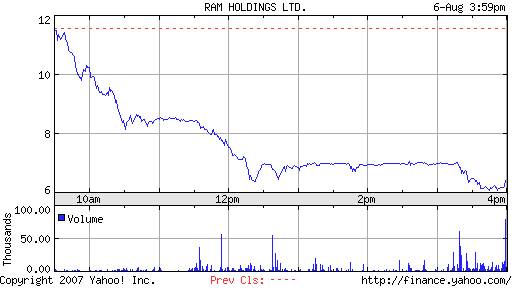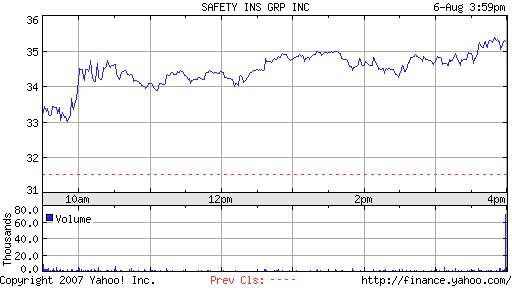A Tale of Two Insurance Companies
 As I write this, I am listening to a replay of the RAM Holdings Conference Call that happened on Monday.? RAM Holdings did not have a good day in the market yesterday, losing 44.5%? of their market value.? What went wrong?
As I write this, I am listening to a replay of the RAM Holdings Conference Call that happened on Monday.? RAM Holdings did not have a good day in the market yesterday, losing 44.5%? of their market value.? What went wrong?
- Investors are more attuned to subprime, and so the merest hint of trouble sends them running for the exits.
- They are more attuned to CDOs, and so the merest hint of trouble sends them running for the exits.
- They commented that premium volume might decline over the remainder of the year.
- They only met the earnings estimate.
- The cost of their soft capital facility has risen to LIBOR+200, the maximum, leading them to question whether they can’t replace the facility with something better.?? (My guess? No.)
- The conference call focused on subprime, CDOs, and the more shadowy bits of their guarantees.
So what does RAM Holdings do?? They reinsure the primary AAA financial guarantors.? They are the only AAA reinsurer that does not compete with the primary insurers.? Typically, they try to take an equal slice of all of the business that MBIA, Ambac, FGIC, FSA, and the three others produce each year.? In that sense, you can think of them as a small version of what the average of the financial guarantee industry would be like if it were a single company.? Unlike a P&C reinsurer, losses kick in only after a threshold is met, and then a lot of losses get paid, with RAM Holdings, the losses are pro-rata from the first dollar.? The primary insurers would have no advantage passing them bad business, because they would be more affected by the bad business.
I’m reviewing RAM Holdings as a possible purchase candidate.? If I were running a small cap fund, I would definitely start tossing some in now.? Why?? It’s trading at less than 35% of adjusted book value, and the balance sheet is good in my opinion, and the opinions of S&P and Moody’s.?? If I were running a hedge fund, I would buy RAM and short equal amounts of MBI, ABK, SCA and AGO.? Why?? If RAM is really in this much trouble, it is likely that MBIA, Ambac, Security Capital and Assured Guaranty are in the same trouble.
Aside from that, their subprime exposure is small-ish and seasoned.? Their CDO exposure is almost all AAA, with super-senior attachment points (i.e. non-guaranteed AAA bonds would have to lose it all before thet pay dollar one of guarantees).? Honestly, I’m probably more concerned about the BBB HELOC and closed-end second lien mortgage exposure.? I would need more data on that before I could act.
 Then there’s Safety Insurance, which was up 12.0% on Monday.? What went right?
Then there’s Safety Insurance, which was up 12.0% on Monday.? What went right?
- Unlike Commerce Group, which missed, they beat estimates handily.
- They raised their dividend by 60%, from $1.00 to $1.60.
- They announced a $30 million buyback (and they have the money to do it).
- The asset side of their balance sheet carries little credit risk.
Now, Safety faces its challenges as the Massachusetts auto insurance market possibly partially deregulates, but Safety has successfully competed in a variety of different market regimes in the state.? The current management team has shown itself to be very adept at adjusting to changing conditions.
Even with change, Massachusetts will still be the most heavy handed state in the US with auto insurance.? It won’t attract a lot of new entrants.? And, it is possible that no change will happen… previous deregulatory plans have come and gone, though this one has more political clout behind it.
Safety is still cheap to me at 1.0x book value, and 7.6x 2008 estimated earnings.? I’m hanging around for more.
Full Disclosure: long SAFT

